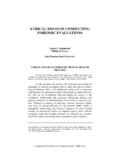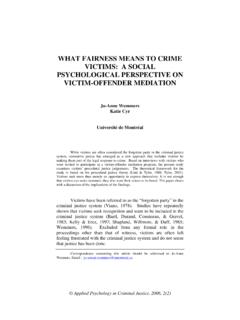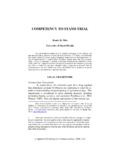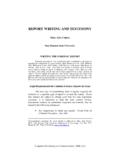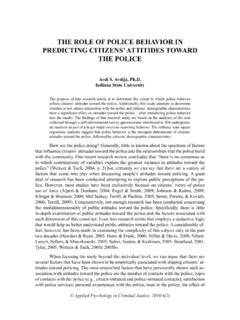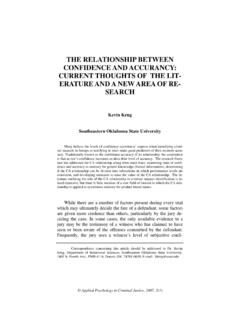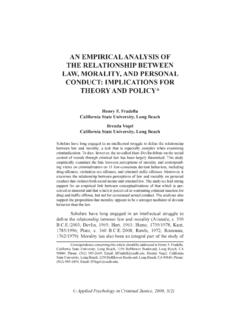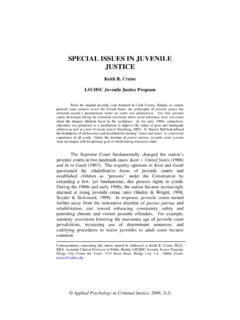Transcription of Malingering - APCJ
1 Malingering . Mary Alice Conroy Phylissa P. Kwartner Sam Houston State University Malingering is almost always a rule-out in any forensic evaluation. The adversarial process and the high stakes involved in criminal proceedings may affect the likelihood that an individual will distort his or her symptom presentation. In cases where a forensic evaluation is sought, the defendant may be feigning illness to gain admission to a psychiatric hospital, to reduce culpability with an insanity defense, or to seek a more lenient sentence. Self-report information is an important aspect of any psychological evaluation. Mental health professionals often proceed on the assumption that clients will provide an honest and complete description of their symptoms. However, this sort of forthrightness cannot be taken for granted when a referral takes place in a forensic context. Distortions in a client's presentation may compromise the accuracy of the psychological evaluation (Rogers, 1997).
2 Assessment of Malingering in a forensic setting is crucial; in fact failure to examine patterns of dissimulation can render an assessment deficient (Bordini, Chaknis, Ekman-Turner, & Perna, 2002). THE DEFINITION OF Malingering . The American Psychiatric Association (2000) has defined Malingering as the intentional production of false or grossly exaggerated physical or psychological symptoms motivated by external incentives ( ). The DSM-IV-TR fails to provide more specific criteria because it does not recognize Malingering as a psychiatric diagnosis, but rather as a condition that may be a focus of clinical attention (APA, 2000, ). In the assessment of Malingering both the client's volition and the presence of external motivation must be examined. The DSM provides a list of situations in which Malingering should be strongly suspected, but Correspondence concerning this article should be addressed to Mary Alice Conroy, Department of Psychology, Sam Houston State University, Box 2210, Huntsville, TX 77341-2210; Email: Applied Psychology in Criminal Justice, 2006, 2(3).
3 30 Malingering . supplies no information about detection strategies to guide clinicians in their work. For instance, a medicolegal context for the evaluation is one situation in which Malingering should be considered. Levels of Malingering Malingering is not an all-or-nothing phenomenon; it exists on several levels. The person who is exaggerating genuine symptoms in an attempt to create the appearance of a more severe form of psychopathology represents one level. Another level of Malingering involves an examinee who uses deceit to extend legitimate symptoms back to the time of the criminal activity in order to reduce culpability. Lastly there are individuals who completely fabricate symptoms for the sole purpose of receiving an external incentive. Malingering and Reliability The difference between Malingering and simple unreliable reporting is a matter of the individual's intent. Malingering , by definition, is deliberate.
4 Both degree of intentionality and distortion should be considered when labeling a potential malingerer. Where intentionality is in doubt, the examinee may be classified as unreliable. The information provided may be inaccurate and not present a valid portrait of the individual's condition, but that is not due to purposeful distortion. As the evidence for dishonest responding increases, so might the level of Malingering from suspected to definite. This classification system provides clinicians with an opportunity to examine their degree of certainty (Rogers, 1997). Malingering and Mental Illness Malingering and mental illness are not mutually exclusive phenomena. An individual might experience depressive symptoms, but feel pressure to exaggerate those symptoms in order to reduce criminal responsibility. Some of the more effective malingerers are those who have experienced or are experiencing actual symptoms.
5 Clinicians should be willing to admit that Applied Psychology in Criminal Justice, 2006, 2(3). CONROY & KWARTNER 31. Malingering and mental disorders may co-exist and some malingerers are simply embellishing symptoms of genuine psychopathology (Rogers & Bender, 2003). Malingering and Factitious Disorders The concept of Malingering may be confused with other disorders, such as Somatoform and Factitious disorders. Therefore, several diagnostic distinctions must be outlined for clarity. The main difference between Malingering and the Somatoform disorders is motivation. Where the feigning of a mental illness or a cognitive deficit is due to a conscious effort, it can be referred to as Malingering , whereas Somatoform disorders are motivated by unconscious or involuntary processes. Factitious disorders can also be distinguished from Malingering in that there are no external incentives present. The malingered presentation extends beyond the patient role and is understandable in light of the individual's circumstances (Rogers, 1997).
6 Prevalence The prevalence of Malingering is unknown and difficult to determine. In a sample of insanity defendants deemed sane, Rogers (1986) estimated that were definite malingerers and approximately 20% were suspected of Malingering . More recently, estimates of Malingering in forensic populations reach 17%. (Rogers, Sewell, Morey, & Ustad, 1996). The accuracy of such estimates is questionable because successful malingerers, by definition, are not detected and thus not included. THE LABEL AND ITS CONSEQUENCES. Probative Versus Prejudicial Courts can exclude relevant evidence if its probative value is substantially outweighed by the danger of unfair prejudice. Use of the term Malingering can be highly prejudicial. The stigma attached to the term far exceeds that of phrases such as unreliable information or inaccurate picture. Decision makers can be easily biased by a conclusion that the examinee is faking a mental disorder by manipulation or lying about symptoms to avoid punishment.
7 A clinician must be very careful in applying the term Applied Psychology in Criminal Justice, 2006, 2(3). 32 Malingering . because adverse outcomes, such as denial of treatment or offense enhancement, may ensue. The use of a stringent threshold is advised to reduce the rate of false positives. The Costs of Successful Malingering There are costs associated with successful Malingering . False claims that are undetected have societal consequences such as increased insurance premiums and diversion of funds from the truly deserving to the undeserving (Bordini et al., 2002). Additionally, where malingerers are not properly identified, the administration of justice will be hampered. Charges might be dismissed and malingerers will achieve their secondary gain by avoiding prison for treatment-based rehabilitation (Frederick, Crosby, & Wynkoop, 2000). The Inpatient Option Intensive observation is often the best method to rule out Malingering , especially with a defendant who is uncooperative or not communicative at all.
8 In a number of forensic contexts the option of an extended inpatient assessment is available. For example, if a defendant is initially found incompetent to stand trial, the law allows for commitment to a hospital to restore competence. If not already incarcerated, this does result in the temporary loss of the examinee's liberty. However, it also allows for around-the- clock observation by trained mental health personnel. Under such circumstances, it becomes extremely difficult even for the most adept malingerer to maintain a consistent symptom pattern. Where an outpatient evaluation has been conducted and Malingering is suspected but the evaluator remains uncertain, giving the individual the benefit of the doubt and recommending inpatient treatment /evaluation may be the most appropriate option. Legal Standards Although the evaluation of Malingering occurs in many forensic cases, it is not addressed specifically in statute.
9 In terms of case law, United States v. Greer (1998), a federal case decided by the Fifth Circuit Court of Appeals, emphasizes the importance Applied Psychology in Criminal Justice, 2006, 2(3). CONROY & KWARTNER 33. of Malingering assessment in court. After a number of mental health evaluations (including one 4-month inpatient evaluation), the trial court found that Mr. Greer was competent to stand trial and had been Malingering his claimed mental condition. Testimony by expert witnesses included an explanation of forced choice testing and conclusions drawn from extensive behavioral observation. The defendant was later found guilty of kidnapping and sentenced for his crime. The court then extended his sentence by 25 months for obstruction of justice based upon his egregious Malingering behavior. In doing so, the court compared his feigning symptoms of mental illness to a situation where someone provides a false handwriting sample.
10 On appeal, the Fifth Circuit Court of Appeals affirmed the trial court's actions and denied the defendant's claim that his Malingering had simply been manifestation of his personality disorder. The U. S. Supreme Court later denied certiorari on the case. Therefore, the decision stands. COLLATERAL INFORMATION IS CRITICAL. Where self-report information is suspect, it is crucial that an evaluator seek alternate sources of information. Key sources of information might include, but are not limited to: school transcripts mental health treatment and evaluation records medical records arrest records correctional records (particularly those relating to grievances and disciplinary infractions). interviews with people who have had contact with the defendant Collateral information allows the evaluator to check for consistency of symptoms and look for contradictions in the examinee's self-report. Reviewing various records and obtaining several points of view facilitates the examination of patterns of behavior.
